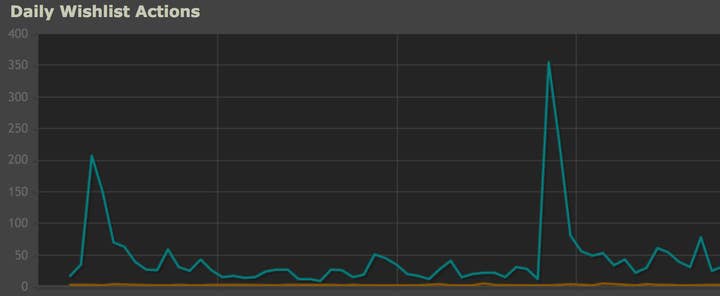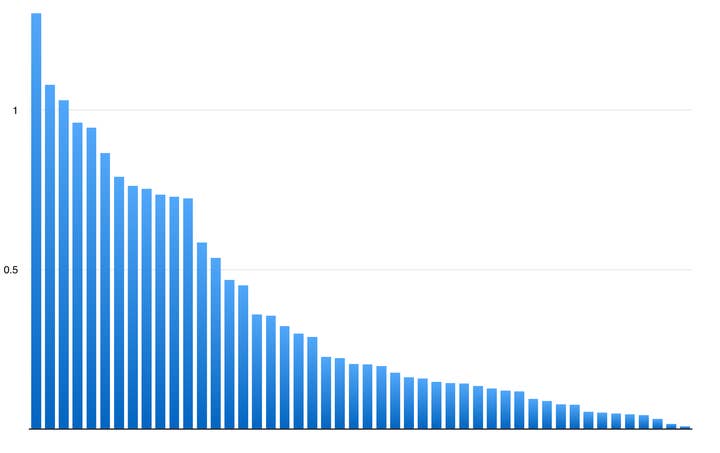Not all Steam wishlists are created equal
GameDiscoverCo's Simon Carless explores why developers are seeing wildly different conversion rates of wishlists after launch
The following column is an adapted version of one featured in the free GameDiscoverCo newsletter from Simon Carless. Carless recently launched GameDiscoverCo as his own research and consulting firm after spending 16 years with the organizer of the Game Developers Conference, Informa, and its predecessor UBM.
Let's start with a simple premise. When you're understanding the potential success of your Steam game before release -- what's the one stat that more people should be paying attention to, but aren't? And to work that out, we need to start with an example…
Case Study: Great Wishlists/Game, Marginal Results?

We at GameDiscoverCo were recently chatting to Fred Tarabout, the creator of Batbarian: Testament Of The Primordials, a Metroidvania with a lot of interesting features/depth. Fred's been working on this title for a number of years, and it just debuted in October to "Very Positive" Steam reviews.
But -- and we don't know exact numbers here -- the game doesn't seem to have performed as well sales-wise as anybody would like, given it has just 70 user reviews on Steam. (Use that GameDiscoverCo research on reviews to sales to get an indicative sales number from there.)
And that's particularly frustrating for Fred and his team, because they'd built up quite a lot of Steam wishlists before release. He shared this annotated graph of how they'd managed to get over 20,000 of them. And in many cases, it was by being in pre-release Steam 'features' or festivals:

In our view, the most dangerous post-Steam release issue is that the game doesn't live up to expectations. And so sales dry up as people check out the page and see 'Mixed' reviews, etcetera.
But this clearly wasn't the case with Batbarian, with its 95% positive player reviews. (It could still pick up, post-release, of course…) So what happened?
Steam Wishlists -- Look at the Troughs, Not the Spikes?
As you may know, we've been talking a lot about wishlist quality recently. And so we went back and asked Fred how many wishlists Batbarian was getting when it wasn't featured in a Steam pre-release event or festival? And he checked, and said it was 5-10 wishlists per day for most of the year before release.
So, if you pretend the game only got eight wishlists per day for an entire year and then launched... well, it'd have more like 2,900 'organic' Steam wishlists at launch. And frankly, the game's performance and its apparent (current!) audience size would make a lot more sense in that context.
Talking to other devs and looking at games we have access to, we've discovered that the natural organic Steam wishlist additions number -- let's call it 'baseline daily wishlists' -- can be radically different from title to title, pre-release.
Thesis: pay more attention to your 'baseline daily wishlists' number.
Why? Well, we've seen it as low as near-zero per day and as high as 200 per day. (It likely goes way higher for big games.) And we're starting to think it has a way better correlation to post-release success than total Steam wishlists at launch.
(Side note: we're suggesting you concentrate on Steam wishlists added and not wishlist balance on individual days. Sometimes when you get in a big pre-release feature you can have more wishlists removed than added afterwards. But that's not what you should worry about -- it's organic additions.)
So, an example: Here's a pre-release Steam wishlist example from a different game we have access to that's been a bit of a 'sleeper' mini-hit. But to start with, it did about 5,000 copies in its first week on sale in Steam.
These are some of the wishlists additions a few weeks before launch. And you can see the baseline daily wishlists are averaging about 25 wishlists added per day:

We also looked at other games. And yes, from data we've seen, it scales in a somewhat inexact but somewhat believable way. (More baseline wishlists, better sales on launch.)
Why think about it this way? Well, the problem with the existing wishlists-to-first-week-sales numbers is that they can be incredibly divergent. It's way more divergent than things like reviews-to-sales, which tend to stay in a narrower 3x band.
There's a reason why Valve says on the record that you can't really extrapolate sales from wishlists, after all. Here's the Week 1 wishlists-to-sales ratios that GameDiscoverCo surveyed -- it varies by a factor of up to 100:

We think there are two reasons for this. The first is everything that comes post-release: particularly does your game meet expectations and get a Very Positive Steam rating, but also do streamers pick it up, does it get word of mouth, etcetera?
But the second is that your pre-release Steam wishlists are of radically varying quality. And I think a lot of games are loading up on the wishlist equivalent of 'empty calories,' pre-release wishlists from (particularly) features and (sometimes) festivals.
The 'Empty Wishlists' Problem
Just to put some emotion and two particular anecdotes around this, this is what GameDiscoverCo said to fellow devs when we discussed this recently:
"We remember when there were less games on the store and you had to push for months and months to get 8,000 Steam wishlists at launch. Why are so many people suddenly launching with 20k-40k wishlists? (I think it's to do with large-scale wishlist dilution around sales and features.)
"You're welcome to add those wishlists -- and they may convert down the line. So don't NOT try to add them, if the cost is reasonable. But we're seeing more disappointment after launches, because devs keep thinking they can bust out a 0.5 first week wishlist-to-sales ratio after getting 90% of their wishlists via these methods."
One tip on this, incidentally. If you see pre-release Steam wishlist spikes that level off gradually, they're probably related to an organic event like a streamer playing it, and may convert better. But if you see a wishlist spike that is straight up and down, it's probably due to a feature that suddenly appears and disappears. And you might want to treat these wishlists differently in your planning.
Two more particular anecdotes around this:
● As part of GameDiscoverCo's client research, we started tracking Discord server join numbers and mapping them to Steam wishlist additions for select client games. We highly recommend you try this. For one game we were looking at, themed pre-release Steam sales (like the ones Batbarian was in) spiked wishlists, but saw basically nobody extra joining the Discord. (Streamers playing the game did increase Discord joins.) Interesting/suspicious, huh?
● In a recent GameDiscoverCo free newsletter, Gary Burchell noted that his new game Sentry received over 1,500 wishlists as part of its Steam page-only 'featured in a pre-release sale' debut. He also worked out: "This would mean that 35% of the store page visits converted to wishlists. I… suspect that many people pressed the "add to wishlist" button that appears on the capsule image from the main Festival sale page." So who adds a game to wishlists and is seriously interested in buying it, without actually looking at the Steam page details? Hmmm…
We wanted to conclude this section by quoting (with permission!) what the perceptive Robert Zubek (SomaSim) said when we talked to him about it:
"Looking at the wishlist pool as consisting of different cohorts that are going to convert differently into players -- this makes total sense to me, because we've seen this player behavior stratification in another corner of the industry: F2P games.
"They quickly found out that installs vary in quality drastically, depending on how the install source matches the game and existing playerbase. if you don't monitor your install spend, and buy the wrong kind of installs, it's really easy to lose a lot of money on players who just install the game out of curiosity, but are not likely to convert into payers.
"So it makes complete sense to me that we'd see this behavior in Steam wishlists too. and it's really unfortunate that Steam doesn't let us do this kind of detailed funnel info of individual player behaviors. All we can get are aggregates, which prevents any kind of funnel analysis."
With the amount of money flowing through Steam and other platforms, it would be great to get more analytics across ALL platforms. (The fact that we're trying to work this out post-hoc, via hack-y monthly wishlist conversion methods is not the best.)
We also respect user privacy, and we suspect this is one of the reasons Valve hasn't gone too deep on this. But... perhaps consider some kind of post-release conversion stats per day, week and month the wishlist was added? That would help a lot, even if we can't tag exactly how wishlists came about.
(Some devs and publishers aren't convinced that all pre-release Steam features -- particularly themed ones like city builder sales, etc. -- are 'worse' for wishlist conversion than regular organic ones. But we can't tell with the current metrics available to us.)
Hook, Line, and Sinker?
Of course, the potentially scary thing about looking at baseline wishlists is how do you even affect your baseline daily Steam wishlists? Isn't that largely about your game's basic attractiveness and hook?
For example, Batbarian is a great title, but is also, arguably, a game in a crowded subgenre which doesn't 'show' outstandingly via trailers or screenshots, due to its spooky dark visual aesthetic.
We do think you can improve your baseline wishlists somewhat over time by a lot of clear communication and community marketing. And by hitting the right outlets and streamers before launch.
Yet your game's core hook and attractiveness -- which you should have gamed out even before you start making it -- are the majority of the reason it should gain 'baseline' daily interest (and pre-release Steam wishlists, which is a proxy for organic interest!)
This 'baseline interest' way of thinking is way more realistic than putting your game in a Steam pre-release feature, doubling wishlists in three days, and thinking sales will double as a result. Which is what you may be doing, 'cargo cult' style, by treating your Steam wishlist total as a monolithic number.
(This article is adapted from an issue of the free GameDiscoverCo newsletter, which is based around one simple issue: how players find, buy and enjoy your premium PC or console game. You can now subscribe to GameDiscoverCo Plus to get access to exclusive newsletters, interactive daily rankings of every unreleased Steam game, and more.)